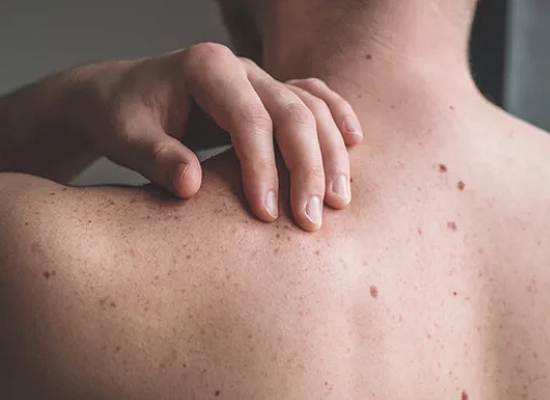
Moles, also known as nevi (singular: nevus), are one of the most common types of skin growths seen by dermatologists. These small clusters of pigmented cells, called melanocytes, can develop anywhere on your body. While most moles are harmless, they should still be monitored regularly for any changes in size, shape, or color. Skin health starts with awareness, and knowing your moles can help you with early recognition of potential skin cancers.
What Do Moles Look Like?
Moles vary widely in appearance depending upon where and when they develop. They can be:
- Flat or raised
- Smooth or rough in texture
- Pink, tan, brown, black, or even blue in color
- Round or oval in shape
- Smaller than a pencil eraser or larger than a quarter
- Hairy or hairless
Some moles are present from birth and/or appear in early childhood. It’s completely normal to develop new moles during childhood and adolescence, but once you reach adulthood, especially after age 40, new moles are less common and should be evaluated by a dermatologist if they appear.
Where Do Moles Form?
These skin growths can develop just about anywhere:
- Face and scalp including lips, eyelids, and ears
- Neck and shoulders
- Back and chest
- Arms, legs, fingers, and toes
- Under the nails
- Genital area
It’s a good idea to check your entire body regularly and take note of any new or changing moles. If you have a mole you want to monitor, take a photo of it with your phone. Take one photo far enough away to show the mole’s location and surrounding anatomic landmarks. Take a second photo of the mole as close as possible. Ensure good lighting, no shadows, and an in-focus picture to capture the features of the mole itself. Repeat the photos at regular 3-month intervals and compare the images for changes. Any changes should prompt evaluation by a dermatologist.
When Should I Be Concerned About a Mole?
Most moles are completely benign, but some can develop into melanoma, a serious form of skin cancer. A good way to monitor your skin is to follow the ABCDE rule for evaluating moles:
- A – Asymmetry: One half of the mole doesn’t match the other
- B – Border: The edges are irregular, ragged, or blurred
- C – Color: Varies in color or has multiple colors
- D – Diameter: Larger than 6mm (about the size of a pencil eraser) or growing
- E – Evolving: Changing in size, shape, or color
Other signs to watch out for include:
- Moles that itch, burn, or hurt
- Bleeding or crusting
- Rapid growth over weeks or months
- Fading or discoloration
If you notice any of these warning signs, it’s important to get evaluated by a dermatologist as soon as possible.
Types of Moles
Not all moles are created equal. Here are a few types commonly diagnosed:
- Congenital nevi: also known as “birthmarks”, congenital nevi are moles that you’re born with or that develop within the first two years of life.
- Common acquired nevi: Moles that develop later in life (usually in childhood or adolescence).
- Dysplastic nevi (atypical moles): These look different from common moles and may have irregular borders, varying colors, or larger size. They carry a slightly higher risk of developing into melanoma. Some people are genetically predisposed to making these types of moles and require close follow up and monitoring with a dermatologist.
Can Moles Turn Into Skin Cancer?
Yes. Although most moles never become cancerous, some will evolve into melanoma. The risk is higher if you have:
- A personal or family history of skin cancer
- Numerous moles (more than 50)
- Fair skin, freckles, and/or a history of sunburn or tanning bed use
- History of atypical or dysplastic moles
- Live at high altitude
Routine skin checks, both at home and in the dermatologist’s office, are essential for early detection.
What Happens During a Mole Check?
During your appointment, a board-certified dermatologist will examine your skin from head to toe. They may use a dermatoscope (a special magnifying tool with light) to inspect moles more closely. If a mole looks suspicious, they may recommend a biopsy to rule out melanoma or other skin conditions.
Can I Have a Mole Removed?
Yes. Even if a mole is benign, you can still have it removed if it causes irritation or for cosmetic reasons. If your dermatologist suspects a mole could be cancerous, they’ll recommend removal for biopsy.
Removal methods include:
- Surgical excision: Cutting the mole out with stitches
- Shave biopsy: Shaving the mole off the surface of the skin
- Punch biopsy: Using a special tool to remove a core of tissue around the mole
Your doctor will discuss the best approach based on your needs.
How to Protect Your Skin and Moles
UV protection is the first line of defense when it comes to preventing both atypical moles and skin cancer. Here’s what you can do:
- Wear broad-spectrum sunscreen daily (SPF 30 or higher)
- Avoid tanning beds
- Wear protective clothing, hats, and sunglasses when outdoors
- Seek shade, especially during midday sun hours (10 AM to 4 PM)
- Perform regular skin self-exams at home
- Selfie photos of moles to monitor for changes at home
When to See a Dermatologist
If you notice any new moles, changes in existing moles, or anything suspicious on your skin, don’t wait. A quick visit to your dermatologist can provide peace of mind or catch skin cancer early when it’s most treatable. Whether you’re worried about a specific mole or just want a skin check for peace of mind, our board-certified dermatologists in Denver/Lakewood are here to help. We offer full-body skin exams, mole evaluations, and personalized skincare advice.
